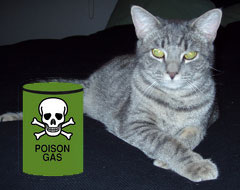Cloned Schrödinger's Cats to Flatten Future Tsunamis
Upton, New York, March 29, 2009 -- A team of physicists at Brookhaven Lab in Upton, New York are currently developing a revolutionary system that will protect coastal areas of the world against future tsunamis using the unique quantum mechanical characteristics of physicist Erwin Schrödinger's cat. The system should be operational within three years or as soon as a sufficient number of Schrödinger's cats can be cloned, whichever comes first.
 STRAI tsunami cat (interior view)
STRAI tsunami cat (interior view)
The project, dubbed the Schrödinger Tsunami Reduction/Abatement Initiative (STRAI) was made possible by the initial discovery of a portion of the preserved remains of Schrödinger's famous cat in a previously unexplored cupboard of his Graz, Austria laboratory, which is now used as a museum. The cat is presumed to have expired between the years 1933 and 1935, the year Schrödinger published his famous "Die gegenwärtige Situation in der Quantenmechanik" ("The present situation in quantum mechanics") in the German magazine Naturwissenschaften ("Natural Sciences").
According to Dr. Ernst Kopecker, a physicist with Brookhaven Lab, in the first stage of the project genetic material from Schrödinger's cat will be cloned by the Oak Ridge National Laboratory in Tennessee to produce a large number of identical cats that will then comprise the heart of the STRAI tsunami system.
"In 1935, Schrödinger published his brilliant paper that laid the groundwork for this revolutionary tsunami reduction system, but due to wartime uncertainties and the unstable state of the world at that time, the system was never fully implemented. What we are doing is to follow up on Schrödinger's work and actually design and launch a functioning system," said Dr. Kopecker.
According to Dr. Kopecker, the STRAI cat system works as follows:
"Schrödinger, in 1935, postulated that one could place a cat in a closed system, such as a box, together with a radioactive nucleus and a container of poison gas. The nucleus is known to have a 50% probability of decaying within a specific period of time. When it decays, the container will open, releasing the gas and killing the cat.
"Quantum mechanics explains that there is no way of knowing whether or not the nucleus has decayed and killed the cat unless you open the box. During that time, the cat is in what is known as a 'superposition' state—the radioactive nucleus is somewhere between not decayed/decayed, and the cat is somewhere between completely dead or completely alive.
"When you open the box, however, something called a wavefunction collapse occurs, and the nucleus and the cat—the moment they are observed—instantly become decayed/dead or not decayed/alive. Our system will use the energy of that wavefunction collapse to fight dangerous tsunamis."
According to the Brookhaven team, the STRAI system will require the installation of a huge network of Schrödinger cats kept in little floating boxes with gas canisters, radioactive particles, and a supply of food, water and fuzzy cat toys. These will be anchored a few miles off the coast along key high-tsunami-risk areas.
The network will in turn be wired to the tsunami warning systems already installed in many areas, and set to pop open the boxes the instant a potentially catastrophic tsunami wave is detected in the region. Each box will be equipped with a small satellite-connected camera set to transmit the image of the cat—and its state of being—to observers stationed in 24-hour observation centers worldwide.
"When the wave comes, the boxes will pop open, the cat will suddenly shift from superposition state to observed state, and the wavefunction will collapse automatically. Bingo, no more tsunami," said Dr. Kopecker.
Initial testing at Brookhaven has determined that the force of the wavefunction collapse of a single Schrödinger's cat unit is capable of flattening a wave area up to half a mile wide, depending on the force of the wave.
"We think two Schrödinger's cats per nautical mile should be sufficient to completely cancel out all but the most devastating tsunami waves," said Dr. Kopecker, "while larger waves will be attenuated to a degree that they should cause little coastal damage."
Dr. Kopecker's work on the STRAI system has not met with universal acceptance, however, with perhaps the most scathing criticism directed from physicist Stephen Hawking, who not only characterizes the Schrödinger's cat method as a mere thought experiment with no practical application in the physical world, but derides the thought experiment itself as having little practical value to the understanding of quantum mechanics due to its overemphasis on the role of the observer.
"What is a thought experiment," countered Dr. Kopecker, "but an experiment that requires some degree of thought as a precondition? I would like to think that every experiment is a thought experiment. One thinks before one performs the experiment, one thinks while one is performing the experiment, and when one is finished, one spends some time thinking about the results of the experiment. That's what experiments are for. Anything else is just entertainment."
By Ion Zwitter, Avant News Editor
Related stories
- AutoChat Fills the Solo Driver's Cell Phone Void
- God Contrite About "Collateral Damage" in Huckabee Tornado Smite Attempt
- China First With Citizen RFID Implants
- Rod and Reel Method May Save International Space Station
- Windows Vista Startup Music Designed on Macs
- Alabama Savant Invents Transistor, Cell Phone, Telegraph
- Ostrich Charged With Multiple Ostricides
- Organic Windows Vista Virus Can Target Computers Even When Powered Down
- God Loses Dice
Copyright © 2005-2505 AvantNews.com. All rights reserved.
Avant News contains satire and other fictional material, provided for entertainment purposes only. Disclaimer. Syndicate. Privacy.











